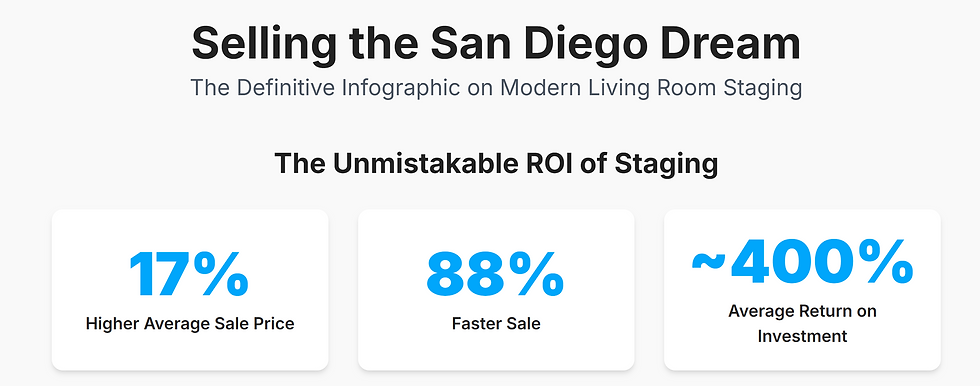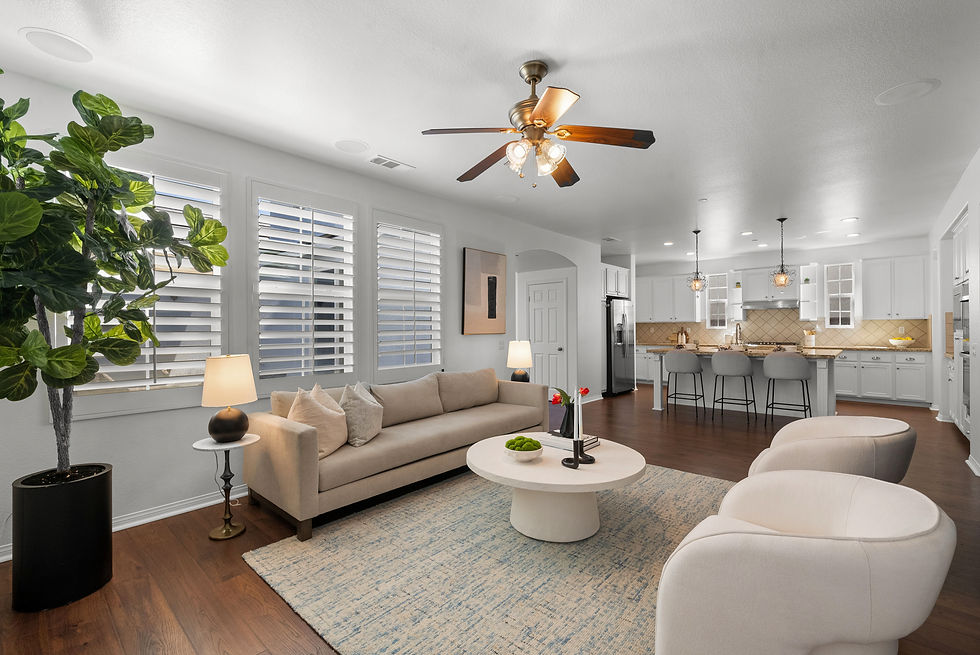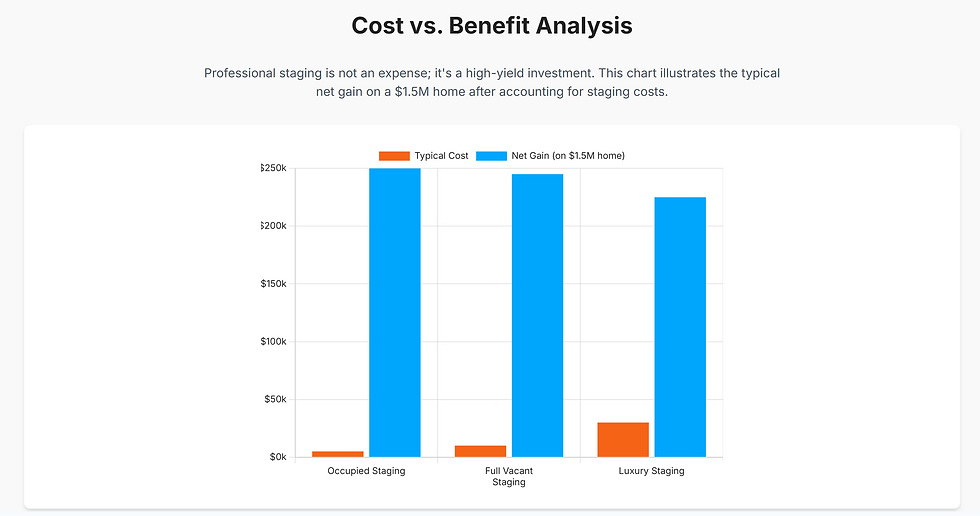The Ultimate Guide to Modern Living Room Staging for a Top-Dollar Sale
- Hooman Arjmand
- Sep 4, 2025
- 10 min read
Beyond Decoration—Staging as a Strategic Investment in the San Diego Market
In the vibrant and highly competitive San Diego real estate market, prospective buyers are not merely purchasing a property; they are investing in a coveted lifestyle defined by sun, coast, and sophisticated leisure.
Home staging serves as the critical bridge between a house as it stands and the aspirational dream a buyer holds. This process involves a sophisticated practice of preparing and showcasing a property for sale through aesthetic strategies like redecorating, rearranging furniture, and deep cleaning to present the home in its best possible light.

Modern living room staging, in particular, is not an optional aesthetic enhancement but an indispensable marketing tool. It is engineered to create a powerful and positive first impression, foster an immediate emotional connection with potential buyers, and ultimately drive a faster, more profitable sale.
Audio Overview
Video Overview
This guide provides a definitive look at leveraging modern staging principles within the unique context of the San Diego market, moving from the compelling financial justification and core design theory to a market-specific analysis and actionable strategies for sellers and their agents.
Sell smarter, not harder. Schedule your FREE consultation with Professional Home Staging In
San Diego, CA and let them guide you through the staging process, stress-free.
The Unmistakable ROI: Why Staging is Non-Negotiable in San Diego
The decision to stage a home is fundamentally a financial one, and the data from the San Diego market presents an irrefutable case for the investment. Professionally staged homes sell for an average of 17% more than their unstaged counterparts, with some reports indicating a potential increase of up to 23%. Furthermore, they sell approximately 88% faster.

This potent combination of a higher sale price and reduced market time generates a staggering return on investment (ROI) of 300-500%. In San Diego's luxury enclaves such as La Jolla, Del Mar, and Rancho Santa Fe, that ROI can climb even higher, reaching 400-600%.
To put this into perspective, consider a typical $1.2 million home in San Diego.
A staging investment of around $6,000 can yield an average return of $204,000 in an increased sale price, making it one of the most profitable pre-sale investments a homeowner can undertake. This financial upside is so clear that staging is often framed as a strategy that costs significantly less than the first price reduction a seller might otherwise be forced to make on an unstaged property.
The compelling financial returns are driven by a deep understanding of buyer psychology. Staging is not simply about making a home look pretty; it is about engineering an emotional response that facilitates a sale.
Visualization is Key: The primary psychological driver is visualization. According to the National Association of REALTORS® (NAR), between 77% and 83% of buyers report that staging makes it easier for them to visualize a property as their future home. This mental transition from viewing a "house" to envisioning a "home" is a critical step in the purchasing decision.
The "Move-In Ready" Imperative: A professionally staged home appears clean, well-maintained, and ready for immediate occupancy. This appeals directly to the 71% of buyers who are actively seeking move-in-ready properties, as it reduces the perceived hassle and potential future costs of repairs or renovations.
Overcoming the "Empty Room" Problem: Vacant homes present a significant challenge for buyers. Empty rooms can feel sterile, cold, and unremarkable, making it difficult for buyers to accurately gauge the size of the space and understand how their own furniture might fit. Staging provides essential context, scale, and warmth, demonstrating the potential of each room.
The Power of the First Impression: Buyers often form a lasting opinion about a property within the first few seconds of seeing it, whether online or in person. With over 90% of buyers beginning their property search online, the superior quality of listing photographs for staged homes becomes a critical competitive advantage. A well-staged home captures more attention, looks better in marketing materials, and ultimately generates more requests for showings.

Beyond the offensive strategy of securing a higher price, staging also functions as a crucial form of risk mitigation, particularly in a shifting or competitive market. The significant reduction in time on the market—staged homes in San Diego sell in an average of 23 days versus 79 for unstaged properties—is not merely a matter of convenience.
Every day a home remains on the market, the seller incurs carrying costs, including mortgage payments, property taxes, and insurance. In a market with increasing inventory or slowing buyer demand, a longer listing time often forces sellers into a price reduction to reignite interest. Therefore, the upfront investment in staging acts as a defensive financial measure, protecting the seller's equity from being eroded by prolonged carrying costs and the need for a substantial price cut.
The Language of Modernism: Core Principles of a Timeless Aesthetic
To effectively stage a home for today's market, it is essential to understand the principles of modern design. It is important to note that "Modern" is not a synonym for "contemporary." Modern design refers to a specific historical movement that emerged in the early to mid-20th century, with deep roots in the German Bauhaus school and Scandinavian design. It is defined by the philosophy that "form follows function," prioritizing purpose and practicality over ornate decoration.

Deconstructing the Core Elements
The modern aesthetic is built upon several foundational elements that work in concert to create a clean, intentional, and sophisticated environment.
Minimalism & Simplicity: At its core, modernism is about stripping away the non-essential. Spaces are free from clutter and unnecessary flourishes, with an emphasis on the idea that every piece should serve a purpose. The guiding mantra is "less is always more."
Clean Lines & Architectural Harmony: The style celebrates strong geometric forms, clean, straight lines, and bold silhouettes. Rather than imposing a style onto a room, modern design seeks to work in harmony with the existing architecture, enhancing its structural elements.
Neutral Color Palette: The foundation of a modern interior is a monochromatic and neutral color palette. Shades of white, beige, gray, and black create a serene and clean canvas that allows the form and material of the furnishings to take center stage.
Natural & Honest Materials: Modern design has a deep appreciation for the inherent beauty of materials. It emphasizes the use of natural elements like unpainted wood, metal, leather, stone, and glass, allowing their authentic textures and qualities to be a primary design feature.
Functionality & Openness: Practicality is paramount. Modern design favors open floor plans where spaces flow into one another, often using furniture arrangements rather than walls to delineate different functional zones.
These aesthetic choices are guided by the seven fundamental principles of interior design, which provide a theoretical framework for creating a successful modern space: Balance, Unity & Harmony, Rhythm, Emphasis (Focal Point), Contrast, and Scale & Proportion. The core tenets of modernism are not merely stylistic preferences; they are strategically aligned with the primary psychological goals of home staging, making it the ideal functional aesthetic for preparing a home for sale.
Capturing the Coast: Defining the "California Modern" Style
While pure, stark modernism provides an excellent foundation, it can sometimes feel cold or impersonal. In the San Diego market, the most successful staging aesthetic is an evolution of this style known as "California Modern" or "California Cool." This approach infuses the clean lines of modernism with the warmth, texture, and relaxed ethos of the coastal lifestyle, creating a look that is both sophisticated and inviting.

Key Characteristics of California Modern
This style is defined by its connection to the unique environment and culture of Southern California.
Seamless Indoor-Outdoor Flow: This is the single most important feature of the style and a top priority for San Diego buyers. The design emphasizes a fluid connection between interior and exterior spaces through the use of large sliding glass doors, expansive windows, and thoughtfully furnished patios or decks that function as true extensions of the living area.
Warm, Organic Palette & Textures: The color palette remains rooted in neutrals but shifts toward warmer tones of white, beige, and soft gray. This base is then layered with earthy accent colors that reflect the natural San Diego landscape: the blues of the ocean, the terracotta of the canyons, and the sage green of coastal flora. There is a heavy emphasis on layering natural textures, including linen, rattan, driftwood, and warm woods.
Minimalist, Yet Inviting: The principles of simplicity and functionality are maintained, but with a clear focus on comfort and livability. Furniture, such as low-profile sofas and sculptural chairs, often features organic shapes, softened with plush area rugs, linen drapes, and textured throw pillows.
Coastal & Boho Influences: The aesthetic is further enriched by incorporating subtle coastal elements like weathered wood and sophisticated nautical themes, as well as bohemian touches such as handcrafted ceramics and curated vintage pieces.
This specific aesthetic directly targets the expectations of the local buyer pool, who value modern upgrades and comfortable, move-in-ready interiors that reflect the region's coveted coastal lifestyle. In this market, authenticity of materials is the new luxury, and the goal is not just to make a living room look good; it is to make it look like it belongs in San Diego, resonating with the soul of a local buyer.
The Living Room Transformed: A Practical Guide to Modern Staging
Translating the principles of California Modern design into a staged living room requires a methodical approach that addresses furniture arrangement, lighting, and material selection.

The Art of Arrangement: Mastering Space, Flow, and Conversation
The placement of furniture is the foundation of a well-staged room. The first and most crucial step is often subtraction—professional stagers frequently remove up to half of a room's existing furniture to create an open, airy atmosphere.
A far more effective strategy than pushing furniture against the walls is to "float" the main seating pieces in the center of the room. This creates intimate conversational groups and makes the layout feel more sophisticated. The arrangement should establish a clear focal point, create obvious traffic paths, and use a large area rug to anchor the entire seating area.
A Symphony of Light: A Layered Illumination Strategy
Lighting is one of the most powerful tools in staging. In a style that celebrates the California sun, maximizing natural light is paramount. Replace heavy drapes with light, sheer window treatments that are hung high and wide to make windows appear larger.
A well-lit room also relies on a combination of three distinct layers of artificial light: Ambient (overall illumination), Task (focused light for activities), and Accent (directional light to highlight features). It is crucial that all bulbs in a room are consistent in color and brightness to create a warm, professional look.
The Curated Palette: Mastering Color, Texture, and Materiality
With furniture and lighting in place, the final layer involves the careful selection of colors, textures, and accessories. A simple and effective framework is the 60-30-10 Color Rule: 60% of the room should be a dominant neutral color (walls), 30% a secondary neutral (sofa, rug), and the final 10% a carefully chosen accent color (pillows, art).
Texture is what prevents a neutral room from feeling boring. Create contrast by layering a variety of materials: a sleek leather sofa with a chunky knit throw, or a soft armchair next to a natural wood coffee table. Finally, accessorize with intent, grouping items in odd numbers and incorporating natural elements like potted plants to reinforce the California Modern aesthetic.
The Professional's Eye: Advanced Techniques and Critical Pitfalls
Beyond the fundamentals, professional staging employs advanced psychological strategies and requires a keen awareness of common mistakes.
The most effective staging begins with a thorough editing process. This involves depersonalization (removing family photos and personal items), deep cleaning, and making necessary repairs. The goal is to create a blank canvas, allowing buyers to project their own future onto the home. A sparkling clean home signals that the property has been well-maintained, while fixing minor issues prevents buyers from wondering about larger, hidden problems.

Even with the best intentions, several common pitfalls can compromise staging. The single biggest risk is creating a sterile showroom that feels cold and uninviting. This is avoided by layering textures and incorporating organic elements. Other mistakes include ignoring the home's architectural context, using furniture with poor scale and proportion, and forgetting about curb appeal—the buyer's first impression is formed before they even step inside.
A Guide to Professional Staging Services
San Diego boasts a robust professional staging industry with firms offering a range of services. A one-time consultation may cost $300-$500. Staging an occupied home, using existing furniture supplemented with curated pieces, generally ranges from $2,000-$5,000. For a vacant home, a full staging service can range from $3,000 to over $10,000, with luxury properties commanding investments of $15,000 or more.

When you consider the powerful ROI, this cost is reframed not as an expense, but as a high-yield investment vehicle designed to maximize the final sale price.
A Curated Directory of San Diego's Premier Staging Professionals
The local market offers a wide array of talented staging companies. Here are a few notable firms:
Mid Modern Designs: Specializes in both modern and classic styling across San Diego County.
HomeScapes San Diego: An award-winning firm with over 15 years of experience known for achieving quick sales.
Outstaging: Focuses on affordable, high-impact staging for smaller properties.
The Stagency: Offers a unique, integrated service of "Staging + Upgrade Services."
BlueGrape Staging: A leading luxury staging brand with expertise across diverse architectural styles.
Showhomes San Diego North Coast: Concentrates on the luxury market in communities like Rancho Santa Fe.
Maha's Home Staging: Known for captivating transformations showcased in an extensive "Before & After" gallery.
UrbaneNest: Features case studies where their restaging led to successful sales for properties that had previously languished on the market.
Conclusion: Staging for Success—Your Final Step to a Premium Sale
In the sophisticated and discerning San Diego real estate market, modern living room staging has transcended its role as a mere decorative service to become a strategic and financial imperative. The evidence is unequivocal: it is the single most effective method for forging an emotional connection with buyers, a connection that translates directly and measurably into a higher final sale price and a significantly faster transaction.
By understanding and implementing the principles of the California Modern aesthetic, sellers can transform their properties from simple structures into compelling, aspirational products. This approach speaks directly to the desires of the local buyer, allowing them to envision a life of relaxed sophistication.
By embracing this strategy, you are not just preparing a house for the market; you are curating an experience, selling a coveted lifestyle, and taking decisive control of your financial outcome. Consulting with a professional real estate agent and a certified local stager is the crucial final step to developing a tailored plan that will unlock a property's true potential and ensure that no money is left on the table.


Comments